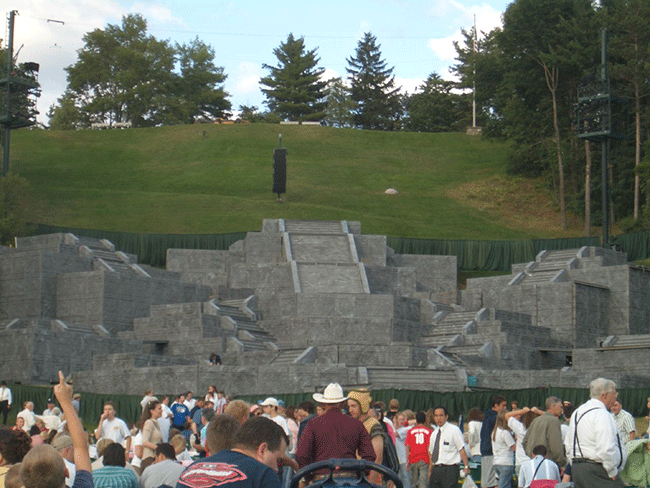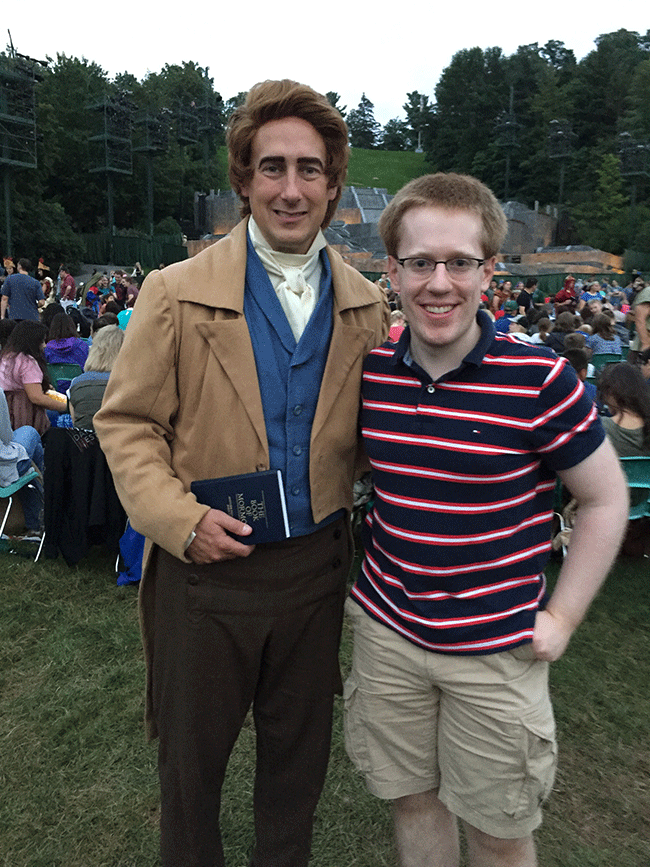
Daniel Gorman Jr.
The area around Rochester, N.Y., the heart of the historic Burned-over District, has an abundance of religious landmarks. Joseph Smith, founder of Mormonism, grew up less than thirty miles from my university. I took advantage of my proximity to Latter-day Saint historic sites to attend the annual Hill Cumorah Pageant. This stage adaptation of the Book of Mormon is a major local event, but it also has international appeal. Latter-day Saints travel tremendous distances to watch the theatrical version of their foundational myth. I saw Ontario, Utah, Missouri, and Nebraska license plates, among others, in the field that served as the festival’s parking lot.
I am not a Latter-day Saint, and I have not read the entire Book of Mormon, only excerpts, plus historians’ analyses of the text. This pageant was my first proper immersion in the saga of Lehi’s exodus from Israel to ancient America, the war between the Nephites and Lamanites, and the coming of Christ to the First Peoples. Even as I experienced the pageant as entertainment — a grand retelling of American mythology — I tried to connect the show to the topics I had recently studied for a Ph.D. field exam. I was juggling the hats of critic, scholar, and spectator at Cumorah.
After threading my way through angry Pentecostal protesters and wary state troopers at the gate, I was struck by the pageant ground’s pleasant and slightly surreal mood. The complex combined Disney World production values with aspects of a summer camp. An enormous multi-tiered stage, evoking a Mesoamerican pyramid, loomed on the hillside, surrounded by concert-grade light and speaker arrays. Below, in a flood plain, several thousand guests — mostly families and summer camp groups — sat in plastic bucket chairs, the kind found in elementary schools. Above: Hollywood; below: campground devotional time.

Cast members dressed as Book of Mormon figures wandered the grounds, behaving exactly like costumed theme park characters. Kids, when not playing Frisbee or eating snacks from the vendors, lined up to take pictures with their favorite prophet. Families took selfies with relatives performing that night. “Joseph Smith” was by far the most popular character to meet. The performers’ outfits had an endearing, homemade quality — not quite Hollywood-grade textiles or needlework, and sometimes ill fit to the volunteer actors, but colorful and utilitarian.
As with the tiered set, the costumes mashed up the vibrant, comic-book aesthetics of Cecil B. DeMille’s Biblical epics with vaguely Mesoamerican motifs. A glance at the pageant program, however, revealed historic photos of past pageants, in which white male performers donned Native American feather headdresses and face paint. No interpretive comments were supplied for these images, which evoked the Native stereotypes seen in movies of the 1940s–50s. The lack of such obvious cultural appropriation in the modern pageant’s art direction indicates that the producers want to avoid criticism regarding race.
It will always be questionable for white LDS volunteers to play Native Americans, but one could argue that it is equally questionable when American children play Joseph and Mary, who were Middle Eastern Jews, in Christmas pageants. I would speculate that, for most attendees at such pageants, the race of the actors matters less than the thrill of seeing one’s friends and family play revered religious figures. Casting practices that would be objectionable in a work of secular theater are smoothed over for the sake of religious veneration.
The Hill Cumorah has many aspects of a local church production, despite its immense physical plant. Volunteers work for two weeks in the summer, learning fight choreography and pantomime acting. Their guileless approach to theater was sometimes evident in the performance — slightly uncoordinated dancers, trumpeters miming to a pre-recorded soundtrack, and sleepy costumed children tugged along by their also-costumed parents. The crowd did not seem to mind, though; audience members clapped and laughed during familiar bits of Scripture. As with the pageant’s tricky racial politics, any lapses in the staging did not elicit a negative response. Mormon guests were here not just for entertainment, but also to witness the volunteers’ collective religious testimony. Indeed, several actors were so invested in the performance that they lip-synched to their lines. The division between themselves and their Scriptural counterparts was blurring. Any ironic moments or incongruities in the show’s mise-en-scene did not disrupt the testimony.
LDS novelist Orson Scott Card’s script for the pageant is written in the declamatory and exposition-laden style typical of old Hollywood Bible pictures — with some distinctly LDS themes woven into the pious dialogue. Most of these themes are apparent in regard to Nephi, the devout son of Lehi who helps his people sail to America. Nephi professes that he can build a ship and perform other works, despite his lack of education, because he has faith in God. This belief that an elite education is not necessary — that ordinary people can do God’s work — is exactly the sort of religious populism that emerged in nineteenth-century America, as Nathan O. Hatch describes in his seminal book The Democratization of American Christianity. When Joseph Smith, a common farmer, translates the Book of Mormon in the pageant’s final scene, he creates a thematic continuity with Nephi, suggesting that American-style religious populism has its roots in a mythic past.
The pageant’s treatment of Nephi also touches on Hermeticism, a strand of occultism that greatly influenced Smith. As historian John Brooke writes in The Refiner’s Fire and Catherine L. Albanese writes in A Republic of Mind & Spirit, Hermetic philosophers believed that they could become magi, powerful figures who, like the Biblical Adam, could control and even create demigods, angels, and spirits. When the pageant features Nephi’s first divine vision, in which God and the angels reveal the Tree of Life and Mormon cosmology, Nephi becomes the quintessential Hermetic magus, imbued with a private, supernatural body of knowledge.
As entertainment, the pageant is engrossing, though not 100% family friendly. I wondered how LDS parents would discuss with their children the scene in which the prophet Abinadi is burned alive. The death of Abinadi is nonetheless achieved with spectacular special effects. Other scenes — the set’s transformation into Lehi’s ship, the light-up Tree of Life, and the risen Christ’s sudden appearance midair — featured equally transfixing imagery. Based on the reactions of the Mormon elementary students sitting in front of me, the effects were the most popular part of the evening. The show reinforced their sense of wonder regarding their religion.
The Hill Cumorah pageant gives the Book of Mormon the blockbuster treatment. Like the typical American blockbuster film, there are wooden moments and problematic issues in terms of casting. Nonetheless, the overall effect is overwhelming, and multi-layered. The pageant is community theater crossed with a religious mission, staged with a million-dollar budget yards from the woods where Smith once dodged bandits determined to steal his golden plates. Hill Cumorah is a major world religious site and the home of an American Oberammergau, a passion play meant to show God’s special plan for the United States. By combining Americana, worship, summer vacation, and theater, the pageant is a unique part of our religious landscape.
Daniel Gorman Jr., is a PhD student at the University of Rochester who researches the history of American religion and culture in the nineteenth century.
